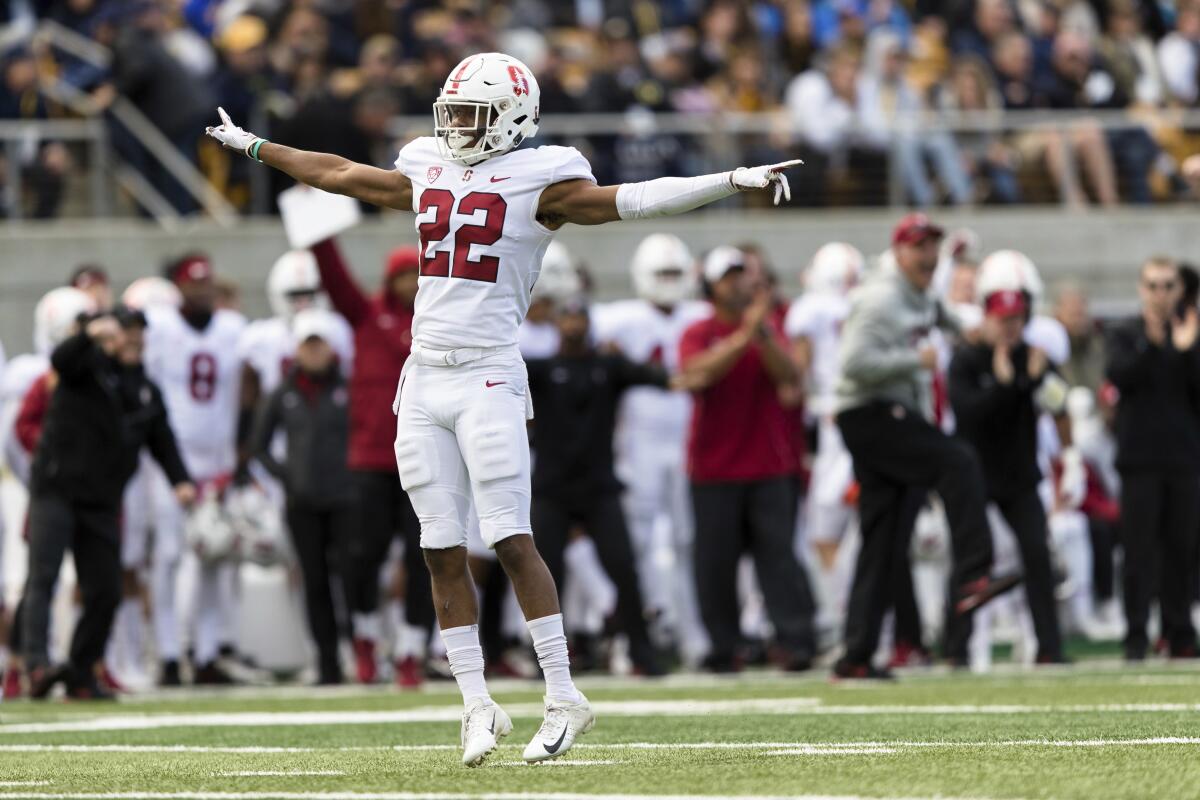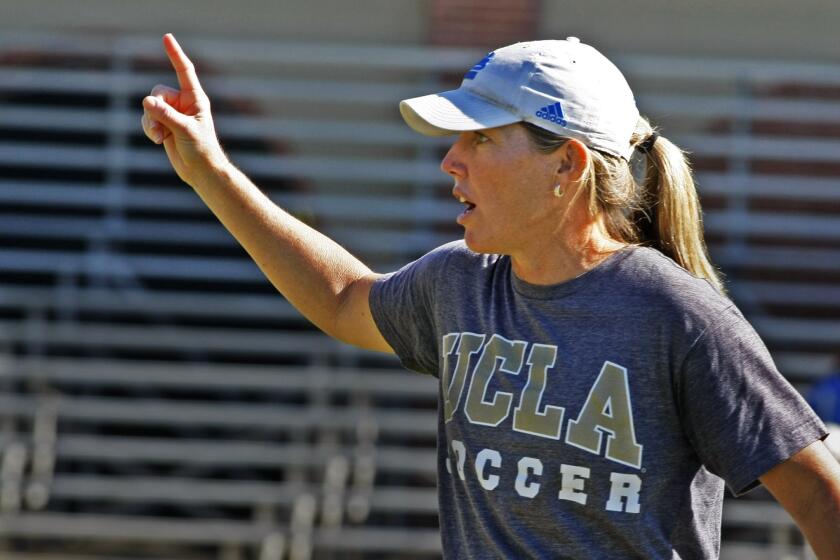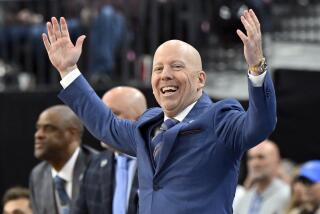UCLA athletes adjusting to campus workouts during time of coronavirus
- Share via
Karina Rodriguez always looked forward to this time of the year. The senior defender on the UCLA women’s soccer team understands how much of the team’s success during the fall begins during the summer. So when UCLA reopened its campus to student-athletes for voluntary workouts last month, she was eager to join, even if things looked different.
Thermometers, questionnaires and masks replaced hugs, high-fives and full team meetings. She couldn’t get into the locker room. Access to the Acosta Training Center was limited. But waiting at the practice each day after Rodriguez completes a survey, scans into the building with her Bruin cards and gets her temperature taken is a familiar sight: her teammates.
That one thing may make up for all of the strange differences.
“We might be six feet apart, but we’re getting through it,” Rodriguez said. “I’m thankful for anything they’ll let us do together.”
Athletes from UCLA’s fall sports teams returned for voluntary workouts starting June 22 as the school began its return-to-play plan that divided athletes into four groups that would move through four phases, from returning to campus safely, starting voluntary workouts, organizing team practices and ultimately returning to competition. All football players and local athletes from Olympic sports could begin the process first. Basketball players were in the second group, with remaining fall Olympic sport athletes and all other local athletes following before all athletes would be welcomed back with the last group.
In her role at Blue Elan Records, former UCLA basketball player Kacy Swain hopes she can bring about change in the music industry.
Almost a month since starting, UCLA has not advanced to the second group of athletes, and the first group is stalled at individual, voluntary workouts as California has struggled to contain the coronavirus outbreak. The state reported 12,807 new cases Wednesday, according to Gov. Gavin Newsom, a record for one day. L.A. Mayor Eric Garcetti has warned that the city is close to a second stay-at-home order, and L.A. County had 2,207 people hospitalized with confirmed coronavirus infections Monday, the fourth-highest daily total. The peak came Saturday at 2,232.
Citing the negative trend in health and safety indicators, the Pac-12 Conference on July 10 delayed the start of mandatory athletic activities. In June, the NCAA set a preseason football calendar that would have started mandatory workouts for a team such as UCLA, which was supposed to start its season Aug. 29, on July 6, walk-throughs and meetings on July 17, and practices on July 31.
Some of the deadlines are already in the rearview mirror. The Pac-12’s nonconference games, including UCLA’s opener against New Mexico State, have been canceled. Workouts remain voluntary.
Yet every day, Obi Eboh dutifully and happily arrives at the gate. The graduate transfer cornerback from Stanford has grand plans for his UCLA debut, even if the season itself it still written in pencil.
“For me personally, I want to be able to be a leader on the team and someone that has a voice and someone that has influence,” said Eboh, who started six games for the Cardinal last year with 23 tackles. “It was important for me to get here just so that these guys can see my face and see me working hard.”
Eboh wanted to get to campus so badly that he drove 30 hours by himself from his parents’ home in suburban Dallas to UCLA to Stanford and back to UCLA. The trek, split over four days, was worth it, he said, because it meant Eboh didn’t have to add more idle time by quarantining.

As part of the school’s return-to-play protocol, athletes who returned to campus by plane were required to isolate for one week before getting tested for the coronavirus and beginning workouts. Those who drove avoided the extra step. Athletes are assigned to workout groups of no larger than 10 and slotted into specific times. The groups remain the same from day to day, and everyone must be spaced out by at least six feet. Cones on the ground promote appropriate social distancing. After an athlete uses any equipment, it’s sanitized immediately.
Seeing the process, from the daily surveys, the pre-workout check-in process and the regular cleanings is comforting, said Rodriguez, who has 52 consecutive starts entering her senior season. For athletes who wanted to continue working out, but would have had to resort to any open public gyms, the voluntary workouts have been the perfect solution.
“I feel without a doubt safer working out with the training staff at school than I do anywhere else,” linebacker Shea Pitts said. “Everything’s mapped out, everything’s planned out way more efficiently than it would be if I was anywhere else.”
Pitts tried to stay in shape during the quarantine period by running hills near his home in Agoura Hills. He used anything he could find as workout equipment, doing curls with five-gallon water jugs and rigging a pull-up bar with a metal pipe in his room. But after four months of not lifting weights, he wanted to get back into a program at UCLA.
UCLA women’s soccer coach Amanda Cromwell has prepared her team for changes during the COVID-19 pandemic, so the Pac-12’s scheduling move wasn’t a shock.
To ease athletes back into workouts on campus, strength and conditioning staffs spent the first weeks testing fitness and movement quality, including balance, agility and change of direction. After athletes passed the tests, they slowly worked back toward using full weights. Although he was proud of his makeshift quarantine workout program, Pitts admitted even the first stages back in the weight room left him sore for days.
Rodriguez, who had completed the women’s soccer program’s winter conditioning program before the regular spring season was canceled because of the pandemic, was disappointed to see how much muscle she had lost. But she’s learned over the last four months the importance of readjusting expectations.
“It’s tough, it’s different, but it’s the new normal,” Rodriguez said. “We’re just rolling with the punches.”
Each day, the threat of a knockout punch to college sports looms. The Big Ten and Pac-12 have already canceled all nonconference competitions for fall sports. The Ivy League postponed all fall sports until at least January 2021.
This wasn’t the type of senior season Rodriguez envisioned. The Bruins advanced to the NCAA College Cup semifinals last year, and Rodriguez is concerned she won’t get the chance to advance further this season. She’s also hopeful. She knows administrators and coaches want it to happen, so she continues to attend workouts. She puts her mask on, sanitizes her hands and stands six feet from her teammates, all ready for the next task.
More to Read
Go beyond the scoreboard
Get the latest on L.A.'s teams in the daily Sports Report newsletter.
You may occasionally receive promotional content from the Los Angeles Times.








